Proficienttutor
On this page, you find all documents, package deals, and flashcards offered by seller PROFICIENTTUTOR.
- 580
- 0
- 0
Community
- Followers
- Following
580 items
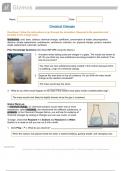
PHYSICAL SCIENCE
Name: Date: Chemical Changes Directions: Follow the instructions to go through the simulation. Respond to the questions and prompts in the orange boxes. Vocabulary: acid, base, catalyst, chemical change, coefficient, conservation of matter, decomposition, dissolve, double replacement, endothermic, exothermic, indicator, ion, physical change, product, reactant, single replacement, subscript, synthesis Prior Knowledge Questions (Do these BEFORE using the Gizmo.) 1. A student mixes baking s...
- Exam (elaborations)
- • 8 pages •
Name: Date: Chemical Changes Directions: Follow the instructions to go through the simulation. Respond to the questions and prompts in the orange boxes. Vocabulary: acid, base, catalyst, chemical change, coefficient, conservation of matter, decomposition, dissolve, double replacement, endothermic, exothermic, indicator, ion, physical change, product, reactant, single replacement, subscript, synthesis Prior Knowledge Questions (Do these BEFORE using the Gizmo.) 1. A student mixes baking s...
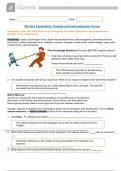
PHYSICAL SCIENCE
Name: Date: Student Exploration: Polarity and Intermolecular Forces Directions: Follow the instructions to go through the simulation. Respond to the questions and prompts in the orange boxes. Vocabulary: dipole, dipole-dipole force, dipole-induced dipole force, electronegativity, intermolecular force, ionic bond, London dispersion force, molecule, nonpolar, nonpolar covalent bond, partial charges, polar, polar covalent bond, valence electron Prior Knowledge Questions (Do these BEFORE usin...
- Exam (elaborations)
- • 4 pages •
Name: Date: Student Exploration: Polarity and Intermolecular Forces Directions: Follow the instructions to go through the simulation. Respond to the questions and prompts in the orange boxes. Vocabulary: dipole, dipole-dipole force, dipole-induced dipole force, electronegativity, intermolecular force, ionic bond, London dispersion force, molecule, nonpolar, nonpolar covalent bond, partial charges, polar, polar covalent bond, valence electron Prior Knowledge Questions (Do these BEFORE usin...
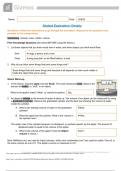
Student Exploration: Density
Name: Date: 12/8/20 Student Exploration: Density Directions: Follow the instructions to go through the simulation. Respond to the questions and prompts in the orange boxes. Vocabulary: density, mass, matter, volume Prior Knowledge Questions (Do these BEFORE using the Gizmo.) 1. List three objects that you think would sink in water, and three objects you think would float. Sink: An egg, a penny, and a rock. Float: A ping pong ball, an air-filled balloon, a boat 2. Why do you think some t...
- Exam (elaborations)
- • 4 pages •
Name: Date: 12/8/20 Student Exploration: Density Directions: Follow the instructions to go through the simulation. Respond to the questions and prompts in the orange boxes. Vocabulary: density, mass, matter, volume Prior Knowledge Questions (Do these BEFORE using the Gizmo.) 1. List three objects that you think would sink in water, and three objects you think would float. Sink: An egg, a penny, and a rock. Float: A ping pong ball, an air-filled balloon, a boat 2. Why do you think some t...
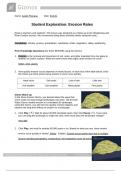
Student Exploration: Erosion Rates
Student Exploration: Erosion Rates [Note to teachers and students: This lesson was designed as a follow-up to the Weathering and River Erosion lessons. We recommend doing those activities before trying this one.] Vocabulary: climate, erosion, precipitation, sandstone, shale, vegetation, valley, weathering Prior Knowledge Questions (Do these BEFORE using the Gizmo.) 1. Erosion is the removal and movement of soil, rocks, and other materials from one place to another on Earth’s surface. Wha...
- Exam (elaborations)
- • 18 pages •
Student Exploration: Erosion Rates [Note to teachers and students: This lesson was designed as a follow-up to the Weathering and River Erosion lessons. We recommend doing those activities before trying this one.] Vocabulary: climate, erosion, precipitation, sandstone, shale, vegetation, valley, weathering Prior Knowledge Questions (Do these BEFORE using the Gizmo.) 1. Erosion is the removal and movement of soil, rocks, and other materials from one place to another on Earth’s surface. Wha...
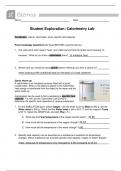
Student Exploration: Calorimetry Lab
Student Exploration: Calorimetry Lab Vocabulary: calorie, calorimeter, joule, specific heat capacity Prior Knowledge Questions (Do these BEFORE using the Gizmo.) 1. The Latin word calor means “heat,” and meter comes from the Greek word meaning “to measure.” What do you think a calorimeter does? to measure heat 2. Where have you heard the word calorie before? What do you think a calorie is? _when looking at the nutritional facts on the back of a_food container Gizmo Warm-up A calo...
- Exam (elaborations)
- • 12 pages •
Student Exploration: Calorimetry Lab Vocabulary: calorie, calorimeter, joule, specific heat capacity Prior Knowledge Questions (Do these BEFORE using the Gizmo.) 1. The Latin word calor means “heat,” and meter comes from the Greek word meaning “to measure.” What do you think a calorimeter does? to measure heat 2. Where have you heard the word calorie before? What do you think a calorie is? _when looking at the nutritional facts on the back of a_food container Gizmo Warm-up A calo...

PULLEYS
ame: Charles Oh Date: 5/28/21 Activity A: Lifting with pulleys Get the Gizmo ready: ● Click Reset . ● Under Pulley type , select 1 fixed . ● Under Object to lift , select Armchair . Question: How do pulleys help us to lift up objects? 1. Hypothesis: Based on what you have seen, what is the relationship between the number of pulleys and the effort needed to lift a heavy object? (Fill in the sentence below.) 2. Collect data: Record how many people it takes to lift the armchair wit...
- Exam (elaborations)
- • 6 pages •
ame: Charles Oh Date: 5/28/21 Activity A: Lifting with pulleys Get the Gizmo ready: ● Click Reset . ● Under Pulley type , select 1 fixed . ● Under Object to lift , select Armchair . Question: How do pulleys help us to lift up objects? 1. Hypothesis: Based on what you have seen, what is the relationship between the number of pulleys and the effort needed to lift a heavy object? (Fill in the sentence below.) 2. Collect data: Record how many people it takes to lift the armchair wit...
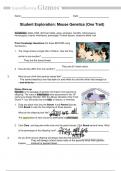
Student Exploration: Mouse Genetics (One Trait)
Name: Date: Student Exploration: Mouse Genetics (One Trait) Vocabulary: allele, DNA, dominant allele, gene, genotype, heredity, heterozygous, homozygous, hybrid, inheritance, phenotype, Punnett square, recessive allele, trait Prior Knowledge Questions (Do these BEFORE using the Gizmo.) 1. The image shows a single litter of kittens. How are they similar to one another? They are the same breed They are different colors. 2. How do they differ from one another? 3. What do you think their ...
- Exam (elaborations)
- • 5 pages •
Name: Date: Student Exploration: Mouse Genetics (One Trait) Vocabulary: allele, DNA, dominant allele, gene, genotype, heredity, heterozygous, homozygous, hybrid, inheritance, phenotype, Punnett square, recessive allele, trait Prior Knowledge Questions (Do these BEFORE using the Gizmo.) 1. The image shows a single litter of kittens. How are they similar to one another? They are the same breed They are different colors. 2. How do they differ from one another? 3. What do you think their ...

Student Exploration: Hardy-Weinberg Equilibrium
Student Exploration: Hardy-Weinberg Equilibrium Vocabulary: allele, genotype, Hardy-Weinberg equation, Hardy-Weinberg principle, heterozygous, homozygous, Punnett square Prior Knowledge Questions (Do these BEFORE using the Gizmo.) Suppose the feather color of a bird is controlled by two alleles, D and d. The D allele results in dark feathers, while the d allele results in lighter feathers. 1. Suppose two Dd birds mate. What percentages of DD, Dd, and dd offspring would you predict? Use th...
- Exam (elaborations)
- • 7 pages •
Student Exploration: Hardy-Weinberg Equilibrium Vocabulary: allele, genotype, Hardy-Weinberg equation, Hardy-Weinberg principle, heterozygous, homozygous, Punnett square Prior Knowledge Questions (Do these BEFORE using the Gizmo.) Suppose the feather color of a bird is controlled by two alleles, D and d. The D allele results in dark feathers, while the d allele results in lighter feathers. 1. Suppose two Dd birds mate. What percentages of DD, Dd, and dd offspring would you predict? Use th...

Student Exploration: Coastal Winds and Clouds
Name: Ashrita Suram Date: 11 - 01 - 2020 The air molecules inside heat up and they expand, as the air expands they become less dense than the surrounding outside air. This causes the balloon to fill up and to begin to float in the air. The more heat you add the lighter the balloon becomes. The air will cool, it becomes more dense, takes up less space, and the balloon will begin to sink in the air. 1. Click Pause ( ) when the sailboat starts moving towards the shore. This represents the ...
- Exam (elaborations)
- • 6 pages •
Name: Ashrita Suram Date: 11 - 01 - 2020 The air molecules inside heat up and they expand, as the air expands they become less dense than the surrounding outside air. This causes the balloon to fill up and to begin to float in the air. The more heat you add the lighter the balloon becomes. The air will cool, it becomes more dense, takes up less space, and the balloon will begin to sink in the air. 1. Click Pause ( ) when the sailboat starts moving towards the shore. This represents the ...

Student Exploration: Ionic Bonds
Name: Date: 22 Jan 20 Student Exploration: Ionic Bonds Vocabulary: chemical family, electron affinity, ion, ionic bond, metal, nonmetal, octet rule, shell, valence electron, ♫heavy metal ♫ Prior Knowledge Questions (Do these BEFORE using the Gizmo.) 1. Nate and Clara are drawing pictures with markers. There are 8 markers in a set. Nate has 9 markers and Clara has 7. What can Nate and Clara do so that each of them has a full set? Nate gives one to Clara2. Maggie is sitting at a table w...
- Exam (elaborations)
- • 8 pages •
Name: Date: 22 Jan 20 Student Exploration: Ionic Bonds Vocabulary: chemical family, electron affinity, ion, ionic bond, metal, nonmetal, octet rule, shell, valence electron, ♫heavy metal ♫ Prior Knowledge Questions (Do these BEFORE using the Gizmo.) 1. Nate and Clara are drawing pictures with markers. There are 8 markers in a set. Nate has 9 markers and Clara has 7. What can Nate and Clara do so that each of them has a full set? Nate gives one to Clara2. Maggie is sitting at a table w...
